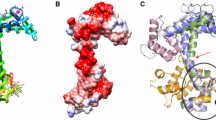Abstract
IQ motif-containing GTPase-activating protein 1 (IQGAP1), which is a well-known calmodulin (CaM) binding protein, is involved in a wide range of cellular processes including cell proliferation, tumorigenesis, adhesion, and migration. Interaction of IQGAP1 with CaM is important for its cellular functions. Although each IQ domain of IQGAP1 for CaM binding has been characterized in a Ca2+-dependent or -independent manner, it was not clear which IQ motifs are physiologically relevant for CaM binding in the cells. In this study, we performed immunoprecipitation using 3xFLAGhCaM in mammalian cell lines to characterize the domains of IQGAP1 that are key for CaM binding under physiological conditions. Interestingly, using this method, we identified two novel domains, IQ(2.7–3) and IQ(3.5–4.4), within IQGAP1 that were involved in Ca2+-independent or -dependent CaM binding, respectively. Mutant analysis clearly showed that the hydrophobic regions within IQ(2.7–3) were mainly involved in apoCaM binding, while the basic amino acids and hydrophobic region of IQ(3.5–4.4) were required for Ca2+/CaM binding. Finally, we showed that IQ(2.7–3) was the main apoCaM binding domain and both IQ(2.7–3) and IQ(3.5–4.4) were required for Ca2+/CaM binding within IQ(1-2-3-4). Thus, we identified and characterized novel direct CaM binding motifs essential for IQGAP1. This finding indicates that IQGAP1 plays a dynamic role via direct interactions with CaM in a Ca2+-dependent or -independent manner.
Similar content being viewed by others
References
Alexander, K.A., Cimler, B.M., Meier, K.E., and Storm, D.R. (1987). Regulation of calmodulin binding to P-57. A neurospecific calmodulin binding protein. J. Biol. Chem. 262, 6108–6113.
Bahler, M., and Rhoads, A. (2002). Calmodulin signaling via the IQ motif. FEBS Lett. 513, 107–113.
Baudier, J., Deloulme, J.C., Van Dorsselaer, A., Black, D., and Matthes, H.W. (1991). Purification and characterization of a brain-specific protein kinase C substrate, neurogranin (p17). Identification of a consensus amino acid sequence between neurogranin and neuromodulin (GAP43). that corresponds to the protein kinase C phosphorylation site and the calmodulin-binding domain. J. Biol. Chem. 266, 229–237.
Blumenthal, D.K., Takio, K., Edelman, A.M., Charbonneau, H., Titani, K., Walsh, K.A., and Krebs, E.G. (1985). Identification of the calmodulin-binding domain of skeletal muscle myosin light chain kinase. Proc. Natl. Acad. Sci. USA 82, 3187–3191.
Briggs, M.W., and Sacks, D.B. (2003). IQGAP1 as signal integrator: Ca2+, calmodulin, Cdc42 and the cytoskeleton. FEBS Lett. 542, 7–11.
Briggs, M.W., Li, Z., and Sacks, D.B. (2002). IQGAP1-mediated stimulation of transcriptional co-activation by beta-catenin is modulated by calmodulin. J. Biol. Chem. 277, 7453–7465.
Ho, Y.D., Joyal, J.L., Li, Z., and Sacks, D.B. (1999). IQGAP1 integrates Ca2+/calmodulin and Cdc42 signaling. J. Biol. Chem. 274, 464–470.
Jang, D.J., Guo, M., and Wang, D. (2007). Proteomic and biochemical studies of calcium- and phosphorylation-dependent calmodulin complexes in Mammalian cells. J. Proteome Res. 6, 3718–3728.
Joyal, J.L., Annan, R.S., Ho, Y.D., Huddleston, M.E., Carr, S.A., Hart, M.J., and Sacks, D.B. (1997). Calmodulin modulates the interaction between IQGAP1 and Cdc42. Identification of IQGAP1 by nanoelectrospray tandem mass spectrometry. J. Biol. Chem. 272, 15419–15425.
Koo, S.C., Choi, M.S., Chun, H.J., Shin, D.B., Park, S.B., Kim, Y.H., Park, H.M., Seo, H.S., Song, J.T., Kang, K.Y., et al. (2009) The calmodulin-binding transcription factor OsCBT suppresses defense responses to pathogens in rice. Mol. Cells 27, 563–570.
Li, Z., and Sacks, D.B. (2003). Elucidation of the interaction of calmodulin with the IQ motifs of IQGAP1. J. Biol. Chem. 278, 4347–4352.
Li, Z., Kim, S.H., Higgins, J.M., Brenner, M.B., and Sacks, D.B. (1999). IQGAP1 and calmodulin modulate E-cadherin function. J. Biol. Chem. 274, 37885–37892.
Mateer, S.C., McDaniel, A.E., Nicolas, V., Habermacher, G.M., Lin, M.J., Cromer, D.A., King, M.E., and Bloom, G.S. (2002). The mechanism for regulation of the F-actin binding activity of IQGAP1 by calcium/calmodulin. J. Biol. Chem. 277, 12324–12333.
Mizumoto, T., Hashimoto, Y., Hirokawa, M., Ohkuma, N., Iizuka, H., and Ohkawara, A. (1985). Calmodulin activities are significantly increased in both uninvolved and involved epidermis in psoriasis. J. Invest. Dermatol. 85, 450–452.
Noritake, J., Watanabe, T., Sato, K., Wang, S., and Kaibuchi, K. (2005). IQGAP1: a key regulator of adhesion and migration. J. Cell Sci. 118, 2085–2092.
Petrova, T.V., Takagi, T., and Cox, J.A. (1996). Phosphorylation of the IQ domain regulates the interaction between Ca2+-vector protein and its target in Amphioxus. J. Biol. Chem. 271, 26646–26652.
Porter, J.A., Minke, B., and Montell, C. (1995). Calmodulin binding to Drosophila NinaC required for termination of phototransduction. EMBO J. 14, 4450–4459.
Rhoads, A.R., and Friedberg, F. (1997). Sequence motifs for calmodulin recognition. FASEB J. 11, 331–340.
Roy, M., Li, Z., and Sacks, D.B. (2004). IQGAP1 binds ERK2 and modulates its activity. J. Biol. Chem. 279, 17329–17337.
Roy, M., Li, Z., and Sacks, D.B. (2005). IQGAP1 is a scaffold for mitogen-activated protein kinase signaling. Mol. Cell. Biol. 25, 7940–7952.
Ruegg, J.C., Zeugner, C., Strauss, J.D., Paul, R.J., Kemp, B., Chem, M., Li, A.Y., and Hartshorne, D.J. (1989). A calmodulin-binding peptide relaxes skinned muscle from guinea-pig taenia coli. Pflugers Arch. 414, 282–285.
Shen, X., Valencia, C.A., Szostak, J.W., Dong, B., and Liu, R. (2005). Scanning the human proteome for calmodulin-binding proteins. Proc. Natl. Acad. Sci. USA 102, 5969–5974.
Swart-Mataraza, J.M., Li, Z., and Sacks, D.B. (2002). IQGAP1 is a component of Cdc42 signaling to the cytoskeleton. J. Biol. Chem. 277, 24753–24763.
Szymanska, G., O’Connor, M.B., and O’Connor, C.M. (1997). Construction of an epitope-tagged calmodulin useful for the analysis of calmodulin-binding proteins: addition of a hemagglutinin epitope does not affect calmodulin-dependent activation of smooth muscle myosin light chain kinase. Anal. Biochem. 252, 96–105.
White, C.D., Brown, M.D., and Sacks, D.B. (2009). IQGAPs in cancer: a family of scaffold proteins underlying tumorigenesis. FEBS Lett. 583, 1817–1824.
Author information
Authors and Affiliations
Corresponding authors
Additional information
These authors contributed equally to this work.
About this article
Cite this article
Jang, DJ., Ban, B. & Lee, JA. Characterization of novel calmodulin binding domains within IQ motifs of IQGAP1. Mol Cells 32, 511–518 (2011). https://doi.org/10.1007/s10059-011-0109-4
Received:
Revised:
Accepted:
Published:
Issue Date:
DOI: https://doi.org/10.1007/s10059-011-0109-4




